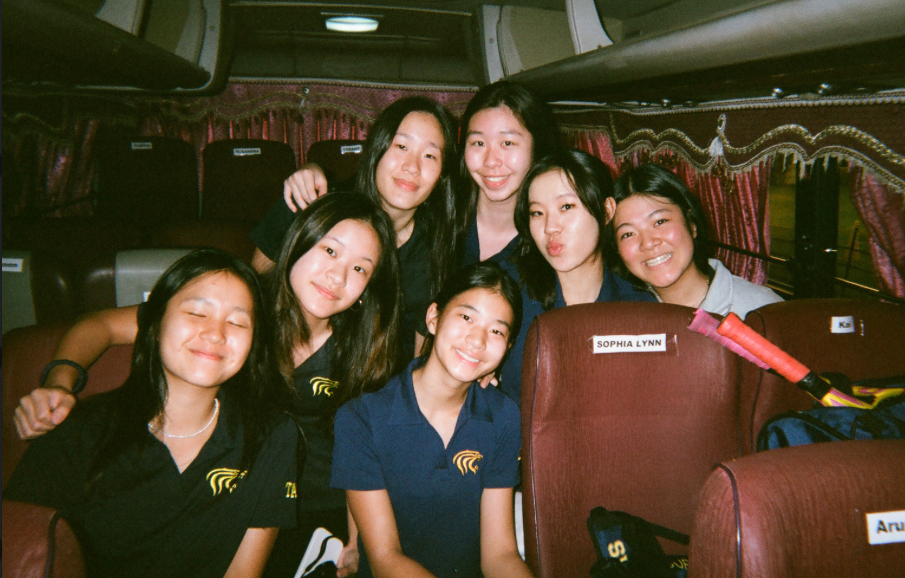The TAS D block water fountain system was closed for over two years before finally reopening on January 19.
“It’s really pathetic,” said Stephanie Lin. “The fountains haven’t been working since forever.”
According to sources, just two months after the opening of the new D block the water fountain system started to produce water quality results that were way below the safety standards of Taiwan and the U.S. It was these alarming reports that closed down the system for over two years.
The problematic history of the fountains raises the question: Is the water safe to drink?
Testing results obtained by The Blue & Gold reveal that even last June the water was still unsafe to drink. These tests looked for total coliforms or total colony counts for Escherichia coli or E. Coli.
The U.S. Environmental Protection Agency states on its website that water with E. Coli colony count that exceeds zero “indicates that [it] may be contaminated by human or animal wastes. Microbes in these wastes can cause short term effects, such as diarrhea, cramps, nausea, headaches, or other symptoms.”
According to Ms. Lin, a medical laboratory scientist at Taiwan Adventist Hospital, the hospital TAS used for water testing, the government standard for safe drinking water is an E. Coli count of zero.
The testing results obtained by The Blue & Gold, however, show readings greater than 200. This is the highest category the hospital will report as it does not continue to count when the number exceeds 200.
“We are looking at something that is 40 times the safety standards,” said Mr. Anderson, the AP Environmental Science teacher at TAS. Though he did emphasize that he is not an expert, the results were disturbing enough for the school to close the fountains for over two years.
“Oh gosh! No!” Mr. Anderson replied when asked whether he would drink water with readings of 200 plus E. Coli colony count.
Sources told Blue & Gold that the drinking water reports on D block’s water fountains have always been inconsistent, swinging wildly from “safe to consume” to “highly contaminated” throughout the building’s history. However, A, B, and C block fountains have never exceeded the maximum contaminant level in the last 10 years.
Mr. Anderson speculated that pipes brought drinking water too close to sewage pipes and a leakage contaminated the water that was already part way to the fountains.
“Some of the fountains were giving water samples that were drinkable, while others were really not drinkable, and that suggests that the water arriving at school probably was drinkable and something was leeching on the school grounds”, said Mr. Anderson. “That’s the only way I can see how some fountains would have drinkable water and others wouldn’t.”
Ms. Lin from the Taiwan Adventist Hospital suggested the same explanation when asked why the old and new buildings produce such different results. According to Ms. Lin, the Taiwanese government’s standard of zero E. Coli count for tap water makes it unlikely that the city water is the source of pollution here at TAS.
TAS maintenance strongly disputes this claim that pipe leakage is the source of contamination, stating that the D block uses a next generation piping system that clearly separates the pipes carrying clean and used water. Pipes are also clearly mapped and easily accessible for maintenance so a leakage is unlikely to go undiscovered.

Mr. Panta, the assistant superintendent who oversees the operations of the buildings at TAS, told the Blue & Gold that the water was safe for consumption but did not meet the school’s own high standards.
“The testing quality didn’t meet our standards,” said Mr. Panta. “The lab came back and said that as far as they were concerned, it’s safe drinking water but the standard wasn’t as high as in [A, B, and C block].”
This differed from Ms. Lin’s comments on the testing results where colony counts were far beyond the safety standards for drinking.
Mr. Panta declined to release any water quality testing reports to The Blue & Gold, stating that the documents were for internal use only.
According to Mr. Panta, fixing the water fountains took more than two years because of the complexity of the system.
“We did multiple test and multiple evaluations,” he said. “We got different companies looking at the problem and why it was there. There was a point in time we solved the problem then we came up with a new problem later on, so it look a while. We were persistent to make sure the testings are consistent.”
Mr. Panta also said the troubled fountains have been closed three separate occasions since the opening of the D block.
“Initially the first problem we had was actually with the tanks up stairs,” he stated. “So we had to solve that problem and for a long time it was good. Then we had another issue with the filters, so we changed the filters. Then the next time we had a problem with the routing of the water, so we’ve had 2 or 3 different problems in that time. To the users it looks like it’s not working and we don’t know why but we’ve actually had two or three different issues we had to dealt with.”
When asked whether more problems might arise in the future, Mr. Panta responded, “You tell me.”
However, a more serious concern may be that fountains are being reopened before proper water testing results are known.
Sources from maintenance say they have identified the problem.
The fountains reopened on Friday, January 16. Students were then able to drink from the fountains since Monday, January 19.
Sources from maintenance say that they test the water before reopening the fountains every time.
Without the dates and water quality testing results to indicate when the fountains were open and when a test was made, it is hard to identify whether or not maintenance is testing the water before reopening the fountains. It is also difficult to determine whether or not students were exposed to unsafe water before test results were received.
“While it is important for us to have access to the water fountains, I don’t think that the maintenance process should be expedited without proper testing first,” said Edmund Tong (11).
The water fountains, with or without prior water quality testing, reopened a fortnight ago for the third time but now without the drinking platforms, meaning students can only get water from the fountains if they have a water bottle ready.
“We found the problem after a long time, and we continue to test the water to make sure the problem has been resolved,” said Mr. Panta. “Our primary focus and concern is making sure [the water] is safe.”
The Blue & Gold commissioned a local government-certified lab on January 23 to test the water quality of D block’s 3rd floor water fountain and water cooler. The test results from that date for both types of water dispensers indicated E. Coli counts that were below one and therefore within government standards.
This report indicates that the water fountains are now safe to drink. But the last two times the fountains have reopened, they were closed within two months due to unsafe E. Coli levels.
With the reopening of the fountains, the troubled history of these water dispensers might finally be over. But the ride to this point wasn’t all smooth as maintenance balanced cost-efficiency, time, and, most importantly, the health of the TAS community.
“We do apologize for the inconvenience… but we just couldn’t take the risk,” said Mr. Panta.




![[PHOTO COURTESY OF PIXABAY]](https://blueandgoldonline.org/wp-content/uploads/2025/03/white-18227_1280-1200x803.jpg)

![[PHOTO COURTESY OF PIXABAY]](https://blueandgoldonline.org/wp-content/uploads/2025/03/fire-6706674_1280-1200x800.jpg)
